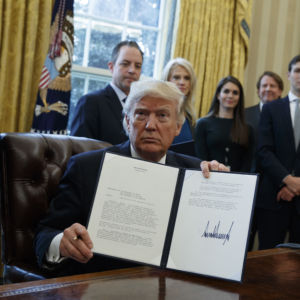It’s over. After months of tents and signs, thousands of police manhours and hundreds of arrests, the Dakota Access Pipeline project is moving forward. On Tuesday morning, President Donald Trump signed an executive order allowing construction of both the Dakota Access Pipeline and the Keystone XL pipeline to proceed.
“This is with regard to the construction of the Keystone pipeline, something’s that’s been in dispute,” said Trump in a signing statement. “We’ll see if we can get that pipeline built. A lot of jobs, 28,000 jobs. Great construction jobs.”
While the Keystone Pipeline required federal approval, Trump’s DAPL memo said the construction of the pipelines furthered “the national interest” and instructed the Army Corps of Engineers and other relevant agencies to expedite the approval process for the pipeline project. Trump also signed a memorandum relating to the construction of pipelines, saying that work would occur “subject to terms and conditions to be negotiated by us.”
North Dakota’s congressional delegation greeted the news with relief.
“We made a strong case with the new administration for approving an easement for the Dakota Access Pipeline project without delay,” said Sen. John Hoeven, who called the move “a step closer to a return to normal.”
“The company has complied with all federal and state requirements and should be allowed to complete the project,” he continued. “Today, the Trump administration followed the law and reversed the Obama administration’s decision to delay the project.”
Hoeven and North Dakota’s other two members of Congress also hope that federal funding to help cover law enforcement expenses will follow the pipeline approval decision.
“The federal delegation and governor are continuing to work together in a bipartisan effort to push for more federal resources for law enforcement,” said Sen. Heidi Heitkamp.
“So far, North Dakota taxpayers have spent more than $22 million on law enforcement resources to make sure all North Dakotans are safe during the protests, and that includes having first responders spend weeks away from their families over the holidays to support the safety of our towns,” she continued. “The administration needs to provide those funds.”
Documents from the Morton County Sheriff’s Department show that providing law enforcement for the protests between August 10, 2016 and January 20, 2017 cost the state highway patrol $4.4 million, of which $2.7 million is potentially eligible for reimbursement.
The Midwest Alliance for Infrastructure Now, which has been advocating for pipeline approval, issued a statement: “We applaud and appreciate President Trump’s immediate and decisive action to expedite the final easement for the Dakota Access Pipeline. President Trump’s decision shows businesses that the rule of law will be respected and demonstrates an affirmation of regulatory certitude to those looking to invest in America.”
Trump’s decision was not altogether unexpected. During the transition period, he met with North Dakota legislators and voiced his support for the project. Despite the setback, native activists and environmental protesters have vowed to continue fighting.
“These actions by President Trump are insane and extreme, and nothing short of attacks on our ancestral homelands as Indigenous peoples,” said Dallas Goldtooth, an environmental activist, who pledged to fight more fiercely to prevent the project from continuing. “These attacks will not be ignored, our resistance is stronger now than ever before and we are prepared to push back at any reckless decision made by this administration.”
The camp’s Medic Healer Council released a second statement, calling the Trump administration’s decision “disheartening but expected” and calling upon it to stop perpetuating “systemic violence” against the protesters.
“We will continue to stand with Water Protectors locally and globally in the intersectional fight for our waters, our lands, and our people,” said Linda Black Elk, the head of the council. “The Medic Healer Council remains committed to protecting the protectors”
Trump’s approval comes two days after the Standing Rock Tribal Council unanimously passed an evacuation order for the camps. The order would close the main Oceti Sakowin, Rosebud, and Sacred Stone camps within 30 days. In addition, the council voted not to provide temporary shelters to anyone remaining at the camp after a February 19 deadline.
During the meeting, tribal representatives voiced their frustration with the protesters, who increasingly interfered with everyday life for area residents.
“What’s that bridge got to do with the DAPL?” asked representative Frank White Bull, in reference to Backwater Bridge, the site of numerous clashes between police and protesters. “We need that bridge.”
Lawmakers from nearby Cannon Ball, ND have also met to formally condemn the continuation of the camps and to forbid the construction of any permanent camp on the site.
“The building of an alternative site for the camp(s) within the Cannon Ball District is not needed or wanted,” read a resolution drafted by area residents. “If there is to be any kind of a ‘site’ for the commemoration of this historic event that took place with all the tribes, the people of Standing Rock need to vote on where, what and cost before any ‘shanty town is built.'”
The Standing Rock tribe has been pressuring the protesters to remove their camp before spring snowmelt in the coming weeks causes the river to flood. Without appropriate preparation, the river could be contaminated by garbage, debris, and human waste from the water protectors’ camp. The tribe’s actions follow more than a month after North Dakota’s governor announced an emergency evacuation order for the area surrounding the camps as a means of urging people to depart.

